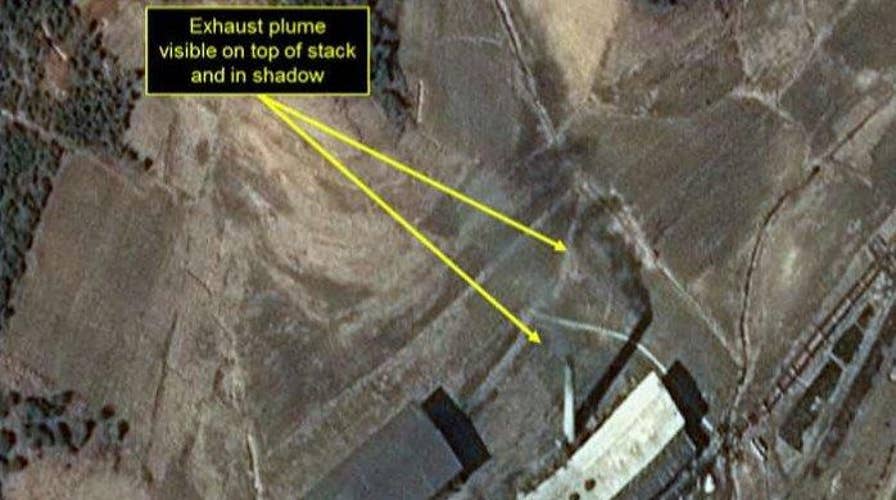Analysts: Photos show new activity at North Korea nuke site
Experts say smoke suggests workers have begun heating the buildings
North Korea has the capability to mount a nuclear warhead on a medium-range missile that could strike targets in Russia, China, Japan and the Korean Peninsula, a South Korean official revealed for the first time Tuesday.
"We believe they have accomplished miniaturization of a nuclear warhead to mount it on a Rodong missile," an official with knowledge of South Korea's assessment of the North’s nuclear program, who spoke on condition of anonymity, told Reuters.
North Korean ruler Kim Jong Un said in March that his country had miniaturized nuclear warheads to mount on ballistic missiles, but the claim was never independently verified.
The official said there is no direct evidence that the North has actually mounted such a warhead on a ballistic missile and declined to elaborate on the assessment.
“Whether they will fire it like that is a political decision," the official told Reuters.
Rodong missiles can fire a 1-ton warhead a distance of up to 1,250 miles, putting all of South Korea, most of Japan and parts of Russia and China in range of a strike.
Despite the North’s persistent threats against the U.S., the country is seen as being several years away from building intercontinental ballistic missiles that can carry nuclear warheads, according to Reuters.
The comments from the South Korean official came as satellite images recorded "suspicious activity" at North Korea's main nuclear complex, according to a report by a U.S.-based think tank.
The report by the website 38 North, which is run by the Johns Hopkins University's School of Advanced International Studies in Washington, claimed that exhaust plumes had been spotted at least twice in the past five weeks at the complex at Yongbyon.
The plumes suggest that the buildings at the complex 56 miles north of Pyongyang are being heated, though it is not clear why.
The lab is where North Korea separates weapons-grade plutonium from waste from a nuclear reactor. The North announced in 2013 its intention to refurbish and restart nuclear facilities, including the reactor, which was shut down in 2007 under aid-for-disarmament negotiations it later withdrew from. The reactor has been the source of plutonium for the North's small arsenal of weapons.
In February, U.S. Director of National Intelligence James Clapper told Congress that North Korea has been operating the reactor long enough that it could begin recovering material for nuclear weapons "within a matter of weeks to months." He was speaking after North Korea had conducted its latest nuclear test explosion in January and then a long-range rocket launch weeks later.
The website said the exhaust plumes are unusual and it had not observed any on commercial satellite imagery during the winter.
"The plumes suggest that the operators of the reprocessing facility are heating their buildings, perhaps indicating that some significant activity is being undertaken, or will be in the near future. Whether that activity will be additional separation of plutonium for nuclear weapons remains unclear," says the analysis by satellite imagery specialists William Mugford and Joseph Bermudez.
North Korean expelled U.N. nuclear inspectors from Nyongbyon in 2009, so it is very difficult to confirm what is happening there.
Daniel Russel, the top U.S. diplomat for East Asia, declined Monday to comment about potential reprocessing activities by North Korea, saying it was an intelligence matter. But he told the Institute for Korean-American Studies that North Korea is facing unprecedented international isolation and "no amount of fissile material" will improve its strategic position.
North Korea has developed two ways to produce fissile material for bombs: enrichment of uranium and separation of plutonium. U.S.-based experts have estimated that North Korea may already have about 10 bombs, but that could grow to between 20 and 100 by 2020.
Tensions are running high on the divided Korean Peninsula. The U.N. Security Council has imposed stiffer international sanctions on North Korea, and since the start last month of annual South Korea-U.S. military drills, the North has threatened nuclear strikes on Seoul and Washington and warned it will test a nuclear warhead and ballistic missiles capable of carrying it.
On Tuesday, China imposed restrictions on imports of coal from North Korea and exports of jet fuel to the North.
The measures ban most imports of North Korean coal, iron, iron ore, gold, titanium, vanadium and rare earths. Such products are a key source of revenue for the mineral-rich North.
China's Ministry of Commerce said an exception would be allowed for materials for civilian use so long as they are not connected to the North's nuclear or missile programs.
The announcement also banned sales of jet fuel to North Korea, which might ground Pyongyang's state-owned airline, Air Koryo.
The U.S. Embassy in Beijing had no immediate comment.
Beijing has balked at previous demands by Washington and other governments to use trade as leverage against North Korea. Chinese diplomats have said the potential humanitarian impact of sanctions had to be considered.
Many analysts believe Chinese leaders are reluctant to impose crippling sanctions on North Korea for fear of destabilizing Kim's government and setting off a possible flood of refugees.
The Associated Press contributed to this report.

